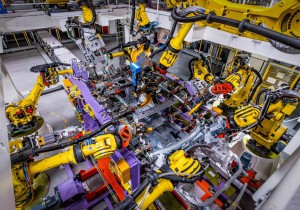
General Motors opened its new plant in Shanghai that will build the Cadillac CT6 for China, which will allow it to avoid the new 10% import tax.
China may be thumbing its nose at the incoming Trump Administration and its push to increase American manufacturing – especially in the automotive sector.
The Beijing government this week decided to add a 10% import tax on super-luxury vehicles, a move it justified by saying it encourages “rational consumption” and should help curb the higher level of emissions those vehicles create.
China’s communist government has some of the world’s toughest rules regarding automotive imports and manufacturing, heavily taxing foreign-made vehicles to encourage local production. So foreign makers must then partner with local auto companies in order to gain access to the market.
Since launching his campaign in 2015, then-candidate Donald Trump has spotlighted trade and manufacturing. He frequently has focused on the auto industry, in particular, Ford’s plans to move small car production to Mexico.
China’s large trade gap with the U.S. has raised numerous concerns in recent years, and the incoming president has signaled that he’d like to see at least some manufacturing operations return from the communist country, as well.
(International trade deals going down in flames. Click Here for the story.)
But, if anything, automakers from the U.S., Asia and Europe continue to invest more heavily in China. That’s in large part to remain competitive since automotive import duties can price foreign-made models out of contention. Cadillac now produces several models in China, while Lincoln is working up Chinese production plans of its own.
Going to China is not as simple as finding a place to build a plant, however. It requires lining up a domestic partner – such as Shanghai-based SAIC, Caddy parent General Motors’ lead ally – and then going through the process of getting bureaucratic approval. That’s why it took several years before Fiat Chrysler Automobiles could start building Jeeps in the communist country.
The latest move on tariffs may not specifically be aimed at bringing more automotive production to China, however. Reports from Beijing suggest the increase may also be part of a crackdown on corruption by President Xi Jinping, who has been enacting a variety of austerity measures and moves meant to get China’s super-elite to stop flaunting their new wealth. The impact has been apparent in a slowdown in the housing market – as well as in the gambling mecca of Macao.
High-line automobiles are also seen by many as a symbol of the pollution problems China has been struggling to deal with. Air quality has plunged to record lows on a number of occasions in big cities like Beijing and Shanghai during the last several years.
(Click Here to read more about Ford and GM’s rising sales in China.)
China’s regulators have been trying to sway the automotive industry away from gas power to electric, a move that has so far had only marginal effect.
The new import tariff won’t affect many, if any, American-made vehicles, as it covers only “super-luxury” models priced above 1.3 million yuan, or $190,000. That’s slightly higher than a Tesla Model X P100d goes for there. The primary targets are European exotics, like Ferrari, Lamborghini and Rolls-Royce.
But the move demonstrates the willingness of the Chinese to move should they want to influence trade and sales of foreign good, in particular.
A hint of just how far President Xi’s government might go came in an opinion piece in the Global Times, a communist party-backed newspaper. “It will be almost impossible for the (U.S.) to restore its glory as a major manufacturing powerhouse under (the Trump) presidency,” the piece declared. It suggested that if companies like Apple make a “show of patriotism” and move production back to the States, Chinese competitors could launch a price war.
(To get a good look at Rolls-Royce’s first-ever SUV, Click Here.)
Whether this is a show of face or a move by Chinese leaders to throw down the gauntlet is far from clear. But it raises the specter of a trade confrontation that could put automotive manufacturers in a tough spot, especially if they hope to retain access to what is now the world’s largest new car market.
